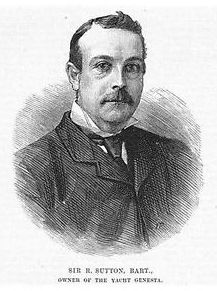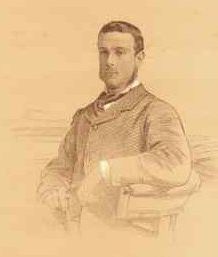Yves GARY Affichages : 3495
Catégorie : PROPRIETAIRES
 Sir Richard Francis Sutton, 5ème Baronnet (20 Décembre 1853 – 25 Février 1891) était le propriétaire du yacht de course Genesta avec lequel il a couru contre Puritan pour la Coupe de l'America en 1885.
Sir Richard Francis Sutton, 5ème Baronnet (20 Décembre 1853 – 25 Février 1891) était le propriétaire du yacht de course Genesta avec lequel il a couru contre Puritan pour la Coupe de l'America en 1885.
Il a été marié à Constance Corbet, fille de Sir Vincent Corbet, Bt., et a eu un fils (Sir Richard Vincent Sutton, 6ème baronnet, voir ci-dessous) qui lui a succédé à titre posthume. Il était le shérif de Berkshire en 1887.
Le Sutton baronnet, de Norwood Park dans le comté de Nottingham, a été créé dans le Baronetage de Grande-Bretagne le 14 Octobre 1772 pour le politicien Richard Sutton. Il était le deuxième fils survivant de l'éminent diplomate Sir Robert Sutton. Ce dernier était le petit-fils de Henry Sutton, frère de Robert Sutton, 1er Baron Lexington. Hugh Clement Sutton (1867 & ndash; 1928), fils de Henry George Sutton, sixième fils de la deuxième Baronet, était un major-général dans l'armée britannique. Dans la fin du 19e et début du 20e siècle, le siège de la famille était à Benham Place. Cependant, la maison a été vendue en 1982.
Sir Richard Vincent Sutton, 6th Baronet
Sutton a combattu comme lieutenant pendant la Première Guerre mondiale et a été blessé au combat en Octobre 1914. Il était l'un des hommes les plus riches d'Angleterre, possédant 13.000 acres (53 km2) et une partie du West End à Londres. Son engagement a été annoncé en 1916. Il a été succédé par son oncle. |
Genesta était un cotre anglais typique de l'époque dessiné par John Beavor-Webb. Ses membrures était en acier avec des bordées en chêne. C'était le premier yacht construit en composite pour la Coupe. Il est arrivé à New York le 16 juillet 1885 après une traversée de 22 jours, le record pour un voilier à travers l'Atlantique. Sir Richard Sutton et John Beavor-Webb sont arrivés quelques jours plus tard.
Voici une première critique de Sir Richard Sutton publiée avant les courses par le New York Times le 31 août 1885.
Après l’accident du 8 septembre dans lequel Puritan a été disqualifié, l’opinion américaine sur Sir Richard Sutton n’était plus la même comme en témoigne cet article publié par le New York Times le 10 septembre 1885.
La belle prestation de Genesta et le grand esprit sportif de Sir Richard Sutton ont créé un sentiment plus amical envers le plaisancier anglais que ce qui avait existé.  La conduite de Sir Richard dans la faute de Puritan lui a valu l'estime de toutes les classes. Son état de santé a été copieusement arrosé lors d'une réception donnée en son honneur le 24 septembre par le New York Yacht Club et il a été fait membre honoraire du club.
La conduite de Sir Richard dans la faute de Puritan lui a valu l'estime de toutes les classes. Son état de santé a été copieusement arrosé lors d'une réception donnée en son honneur le 24 septembre par le New York Yacht Club et il a été fait membre honoraire du club.
Après la Cup, Sir Richard Sutton dispute un certain nombre de régates organisées sur la côte Est à bord de Genesta. Il gagne la Brenton Reef Cup et la Cape May Challenge Cup, qu'il ramène avec lui en Angleterre.
Après son retour en Angleterre Sir Richard Sutton s'est engagé auprès d'une jeune femme qui est tombée gravement malade. Il souhaitait vendre Genesta mais comme il n'a pas trouvé acheteur il a encore fait seulement quelques courses.
Genesta remporte la première course autour de la Grande-Bretagne organisée en 1887 pour les célébrations du Jubilée de la reine Victoria. Mais à cette époque, Irex dominait et Genesta était surclassé.
Sir Richard a abandonné la course et a vendu Genesta qui a ensuite été converti en yawl et a finalement été démoli en 1900. Sir Richard est mort d'une péritonite le 25 février 1891. C'était un plaisancier vif avec un bon sportif: il est regrettable que son mauvais état de santé et celui de son épouse aient raccourci sa carrière de course. Genesta a été l'un des plus beaux navires concourant pour la Coupe de l'America et même s'il a été vaincu, il a fait l'admiration de tous.

 LIEN UTILES
LIEN UTILES
- Sutton baronets - Wikipedia, the free encyclopedia
- Obituary: Sir Richard Sutton - The New York Times 26 February 1891, p. 4.
- SIR RICHARD SUTTON'S COURSE CRITICISED AS UNSPORTSMANLIKE - Front Page - NYTimes.com August 31, 1885
- PRAISE FROM EVERY SIDE; SIR RICHARD SUTTON'S GRACEFUL MAGNANIMITY. - Front Page - NYTimes.com September 10, 1885
